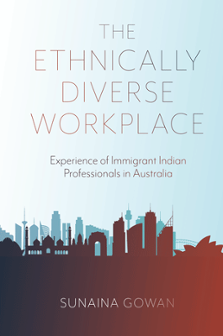The Ethnically Diverse Workplace: Experience of Immigrant Indian Professionals in Australia

Synopsis
Table of contents
(9 chapters)Abstract
Since 1945, there have been significant changes in the pattern of Indian overseas immigration. Australia has become a popular destination for Indians, particularly skilled immigrants, during this time. Until the 1950s, Australia maintained a strict ‘White Australia’ immigration policy, which was eased by a formal agreement to favour immigrants from select European nations, particularly the United Kingdom. The policy’s original aim was to increase the population for defence purposes. Its goal in the 1950s and 1960s was to bring in workers to help with Australia’s industrial development. It wasn’t until the 1970s that Australia began to see the benefits of a multicultural immigration policy, a mostly bipartisan approach that has helped Australia’s economy grow and its society become one of the world’s most progressive. By the early 1990s, the immigration policy had become more flexible, incorporating humanitarian, social, and economic goals. Over the previous two decades, the policy has placed a strong focus on skilled immigration. As a result, Australia now has a genuinely global immigration policy that promotes a culturally diversified and socially united society. In Australia, the pattern of immigration has changed dramatically, and the Indian population is rapidly growing. Even though most of the research on cultural diversity in Australia has centred on unskilled foreign labour, many immigrants hold management positions. On a daily basis, however, several of them face prejudice, discrimination, and racism.
Abstract
Not just in low-wage and low-skilled jobs but also further up in the corporate ladder, Australian corporations have culturally diverse workforces. Due to talent shortages in fields such as medicine, engineering, and education, the Australian economy is reliant on skilled immigrants. As a result, the demand to increase and diversify the workforce is growing, and Australia’s government has focused its efforts on attracting a diverse pool of skilled immigrants. As Australia’s ethnic diversity grows, businesses that want to stay competitive will find that having a diverse workforce provides them an advantage.
Abstract
The ‘Australian workplace’ has been used as a study ground in this book to explore the integration process of immigrant Indian professionals in Australia, as well as the link between exclusion after inclusion and its influence on these professionals’ emotional labour. This chapter will examine how exclusionary inclusion impacts immigrant Indian professionals and how they try to hide or repress parts of their cultural identity to be accepted equally in Australian workplaces. Inclusion is defined as ‘the degree to which an employee thinks he or she is a valued member of the organisation’ (Shore et al., 2011). When they are excluded, they are disappointed and fear losing their cultural identity (Aydemir & Skuterud, 2008). Inclusion in the workplace is closely related to higher commitment and better performance (Cho & Mor Barak, 2008). When ethnic workers feel supported in the job, where they spend a significant amount of their life, they perform better. Skilled immigrants come to a country with hopes and dreams of experiencing equality and finding employment. According to Roberts et al. (2009), when an individual’s internal experiences and external displays are in alignment, they will have no identity conflict and will feel appreciated at work.
Abstract
The continuance of gender inequity has dominated most of the discourse on diversity in organisations. Few studies, particularly in the Australian context, deal with the racialised nature of many professional workplaces. This chapter critically examines immigrant Indian professionals’ experiences of perceived discrimination, exclusion after inclusion, and bias in Australian organisations. It focuses on the complexities of emotional labour, since concealing true emotions and displaying the emotions necessitated by the job can be difficult. Job burnout and stress are possible outcomes of this conflict between required and true emotions. There is a rapidly growing Indian community in Australia. In 2020, there were over 7.6 million migrants living in Australia. This was 29.8 percent of the population that were born overseas. One year earlier, in 2019, there were 7.5 million people born overseas. Those born in India (721,000) were in second place, with an increase of 56,300 people (Australian Bureau of Statistics, 2020a). This chapter examines the challenges and adjustments experienced by immigrant Indian professionals, as well as whether these factors play a role in their workplace integration.
Abstract
This chapter will showcase interesting anecdotes from immigrant Indian professionals working in Australian companies. The central normative dilemma is whether immigrants surrender some aspects of their identity, such as language or fashion sense, to integrate into mainstream Australian culture and institutions. Assimilation is defined as ‘being absorbed into the dominant society’s cultural tradition and thereby losing one’s unique character’ (Garcia & Van Soest, 2006, p. 14). It was discovered that although some immigrants saw the workplace as a cause of ridicule and exclusion, others see it as a means of personal validation and inclusion.
Abstract
The main purpose of this chapter is to provide a comprehensive discourse on whether Indian immigrants succumb to the need to fit in, driving them to assimilate, or if they remain true to their identity. The final revelation through this chapter will be fascinating, allowing for a better recognition and awareness of the dynamics of the Indian diaspora in Australia, as well as the complexities of their assimilation into Australian organisational life. The aim is to highlight the need for organisational support and guidance of immigrants, particularly professionals from India. As a result, this book has significant value since it gives a thorough understanding and in-depth explanation of these integration challenges and adds to the body of knowledge on the integration of immigrant Indian professionals in Australia.

- DOI
- 10.1108/9781803820538
- Publication date
- 2023-01-19
-
- ISBN
- 978-1-80382-054-5
- eISBN
- 978-1-80382-053-8